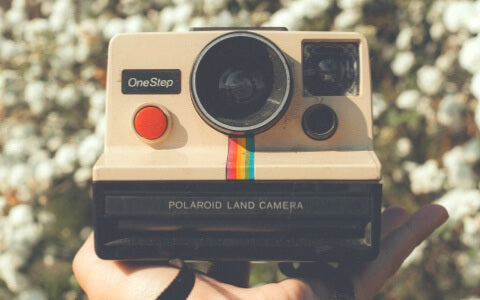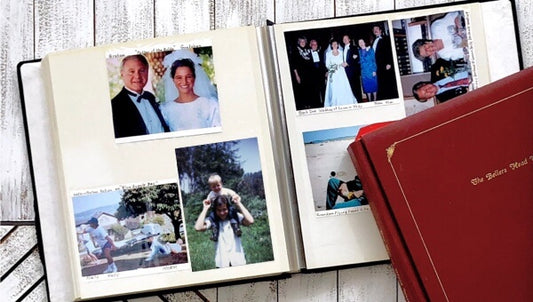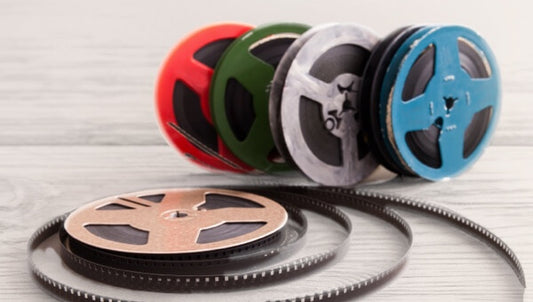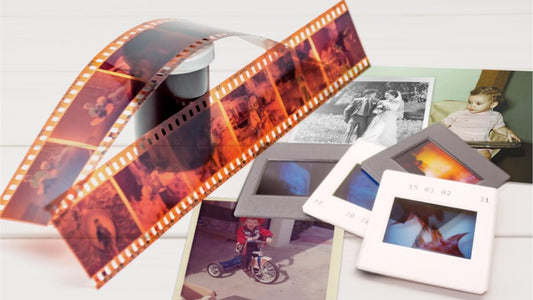Few names in photography evoke as much nostalgia as Kodachrome. For more than seven decades, this groundbreaking color reversal film from Kodak transformed the way people captured their lives, from iconic National Geographic covers to family slides projected on living room walls. Its warm tones, incredible sharpness, and unmatched durability made Kodachrome photos timeless.
At Capture, we’ve helped preserve countless rolls of Kodachrome film and slides, keeping their colors alive for future generations. In this guide, we’ll take you through Kodachrome’s history, its unique color processing, and how to preserve and digitize Kodachrome film today.
Whether you’re curious about what made Kodachrome so special, why Kodak discontinued it, or how you can still experience it today, this is where its story continues.
Jump To:
- What Is Kodachrome Film and Why Was It So Revolutionary?
- The Kodachrome Photography Experience
- How Was Kodachrome Processed?
- The Colorful History of Kodachrome
- Preserving and Digitizing Kodachrome Film and Photography
- Is There a Kodachrome Revival Today?
- Frequently Asked Questions About Kodachrome
- The Timeless Legacy of Kodachrome
What Is Kodachrome Film and Why Was It So Revolutionary?
Kodachrome is a color reversal (slide) film from Kodak that creates a positive image directly on the film for projection and prints. It uses three black-and-white emulsion layers, with dyes formed during development via the K-14 process — not built into the film itself. The result is fine grain, exceptional sharpness, rich yet natural color, and outstanding archival stability, which is why many Kodachrome photos still look vibrant today.

Kodachrome defined photography’s golden age.
When Was Kodachrome Invented?
Kodachrome as we know it was first launched by the Eastman Kodak Company of Rochester, New York in 1935 as 16mm movie film. It later appeared in 8mm and Super 8 movie formats, as well as Kodachrome 35mm film and 828 formats for still photography. Its vibrant, lifelike colors made it a favorite among both professionals and hobbyists.
The story of Kodachrome began with two classically trained musicians and scientists, Leopold Godowsky Jr. and Leopold Mannes, who set out in the early 1930s to create a better color film. Their groundbreaking work changed the course of photography forever.
How Did Kodachrome Change Color Photography?
Before Kodachrome, color photography was limited to early processes like Autochrome and Dufaycolor, which could not reproduce vivid hues. Kodachrome introduced a three-color subtractive process that brought extraordinary depth and realism to images.
Unlike most color films, Kodachrome didn’t have built-in dyes. Instead, the color layers were developed chemically through a complex process that resulted in unmatched sharpness and tonal accuracy. This unique method also gave Kodachrome slides remarkable longevity — many still look vibrant today.
How Did Kodachrome Evolve Over the Years?
Throughout its lifetime, Kodachrome color film underwent several improvements. The 1960s saw the release of Kodachrome II, Kodachrome 25, and Kodachrome 64, which offered finer grain and greater color control.
Though later films like Ektachrome and Fujichrome were easier to develop, Kodachrome’s quality and archival stability kept it popular for decades. It became the gold standard for color photography and cinematography.
Why Was Kodachrome Discontinued?
As digital photography took over in the late 1990s and 2000s, Kodachrome sales declined. Its intricate K-14 processing required specialized chemicals and equipment that few labs could support.
Kodak officially discontinued Kodachrome in 2009, and by 2010, only one certified lab remained — Dwayne’s Photo in Parsons, Kansas. The final roll of Kodachrome ever produced was famously developed there by Steve McCurry for National Geographic, symbolizing the end of a legendary era.
The Kodachrome Photography Experience
If you have Kodachrome slide film, movie film, or any other type of Kodachrome that was released throughout the years,
you may be interested in trying to shoot it. Keep in mind that Kodachrome hasn’t been manufactured since 2009, so any film available today is expired. While expired rolls can still be used, results are often unpredictable, with color shifts or loss of sensitivity.
One important tip is that it’s better to slightly underexpose the film instead of overexposing. Slight underexposure can actually make the colors look better, especially with subtle changes found in nature.
While it might take some practice, slight underexposure can actually make the colors look better, especially with subtle color changes found in nature. You also want to use a manual focus on your camera for the best results and should strive to use a combination of dark and light colors in the frame whenever possible.
What Cameras Work Best with Kodachrome?
Another important factor is the camera that you choose. There are plenty of 35mm and slide film cameras that you can choose from, but it’s a good idea to have one with an interchangeable lens, manual focus, and simple exposure meters. You also want a clear viewfinder. Some good Kodachrome camera options include the Milnolta X300, Nikon FE or FM, Olympus OM-1, or a Canon A-1.

Kodachrome works best with manual 35mm cameras.
Can You Still Develop Kodachrome Film?
Unfortunately, it’s very difficult to find a lab that will process Kodachrome slides or Kodachrome color photos. Some labs still offer development as black-and-white film, which is one option. After that, you can use a Kodachrome slide scanner to digitize the film and even restore color using editing software.
While it may be possible to find a local shop that advertises Kodachrome processing, most no longer support the film because the original K-14 process is obsolete. Processing Kodachrome at home is also extremely challenging — at best, you’ll likely only create black-and-white negatives.
How Was Kodachrome Processed?
The Kodachrome process was unlike any other film development method. Instead of built-in color dyes, Kodachrome used three black-and-white emulsion layers, each sensitive to one primary color (red, green, or blue). During development, dyes were added chemically through the K-14 process, producing the rich, lifelike tones that made Kodachrome photos legendary.
What Was the K-14 Kodachrome Process?
The K-14 process was extremely complex. Unlike simpler films such as Ektachrome, which could be processed in smaller labs, Kodachrome required multiple chemical baths, precise temperature control, and specialized equipment. Because of this, only a limited number of certified labs could develop Kodachrome slide film correctly.
This complexity was also what gave Kodachrome its unmatched sharpness, fine grain, and archival stability. Many Kodachrome slides from the 1950s and 60s still look as bright today as when they were first projected.
What Made Kodachrome Colors Unique and Long Lasting?
Kodachrome is celebrated for its warm, lifelike color, fine grain, and exceptional microcontrast. Its look came from three black-and-white emulsion layers with dyes formed during development, not built into the film.
Because the dyes are created during the K-14 process, Kodachrome slides resist fading and color shifts far better than most transparency films. That’s why many Kodachrome photos from the 1940s–1960s still project with rich reds, natural skin tones, and deep blues.
Photographers prized the tonal separation, clean highlights, and neutrality in midtones. The combination of sharpness and stable dyes gave Kodachrome its archival reputation.
How to help Kodachrome last even longer:
- Store slides cool, dark, and dry in archival sleeves
- Keep away from attic heat and basement humidity
- Handle by the mounts to avoid fingerprints and scratches
- Digitize high-resolution copies for viewing and sharing
- Use digital copies for display to reduce light exposure on originals
The Colorful History of Kodachrome
Kodachrome dominated the market for over two decades and remained an industry staple much longer, leaving a lasting impact on photography and popular culture. More than just a film, it became a visual record of the 20th century.

Warm hues and stability made Kodachrome photos timeless.
Famous Kodachrome Photos
Kodachrome photography was used to capture many of the most iconic moments in history. Some well-known Kodachrome photos include:
- The coronation of Queen Elizabeth II (1953)
- The assassination of President John F. Kennedy
- Steve McCurry’s Afghan Girl, published by National Geographic (1985)
- The Hindenburg explosion (1937)
- Countless family slide shows projected in living rooms across the world
These images highlight why Kodachrome slide film became synonymous with vivid, lasting memories.
Kodachrome in Music and Film
Kodachrome even inspired popular culture beyond photography. Paul Simon’s 1973 song “Kodachrome” immortalized the film’s “nice bright colors,” celebrating its role in everyday life. Decades later, in 2017, Netflix released the feature film Kodachrome, based on a New York Times article by A.G. Sulzberger. The movie, starring Ed Harris, Jason Sudeikis, and Elizabeth Olsen, followed a road trip to the final Kodachrome film lab before it closed — a symbolic farewell to a legendary medium.
As you can see, Kodachrome was not only popular, but captured the hearts and memories of families, professional photographers, and filmmakers throughout the decades.
Preserving and Digitizing Kodachrome Film and Photography
Preserving Kodachrome film is essential if you want your slides, photos, and reels to last for future generations. Although Kodachrome was known for its archival stability, even the best-kept Kodachrome slides and reels can fade, scratch, or deteriorate over time. The best way to protect them is through Kodachrome digitization — turning slides into digital files that can be backed up and shared.”
DIY Kodachrome Conversion Options
One way to convert Kodachrome is to use a photo or film scanner. This allows you to transfer your images or reels to a memory card or hard drive at home. While this can work for small collections, it is often:
- Time-consuming
- Difficult to capture true color contrast
- Limited by the quality of consumer scanners
For formats like Kodachrome 35mm slides, 8mm reels, or Super 8 film, home scanning may not fully capture the richness of the original colors.
Professional Kodachrome Digitization Services
The other option is to use a professional Kodachrome preservation company. Capture uses professional equipment to transfer your Kodachrome 35mm photos and slides as well as a wide variety of other types like 110 and 120 slides, 8mm film, Super 8 film, and 16mm film.
While there are many companies that digitize photos, Capture stands out by investing millions in advanced tracking and security systems to protect your originals. Combined with our satisfaction guarantee, you can have peace of mind as we preserve your Kodachrome memories and legacy forever.

Digitize Kodachrome film to protect it forever.
Is There a Kodachrome Revival Today?
Kodachrome had a lasting impact on photography and even though the film format has been discontinued and very few labs even process Kodachrome anymore, many photographers seek out old films to experience the nostalgia and flexibility of the format.
Even with digital photography offering higher resolution and crisper image quality, the Kodachrome look remains iconic. Its warm tones, rich reds, and deep contrasts are so beloved that many editing presets and camera profiles are designed to mimic the famous Kodachrome color palette.
This imitation underscores Kodachrome’s influence — it wasn’t just film, it was an artistic style that shaped how entire generations saw the world.
While digital photos can offer a significantly higher resolution, better color, and crisper image quality, the iconic impact of Kodachrome is shown by vintage pictures taken with modern cameras. In fact, a few years ago Kodak said they might consider bringing the format back but decided that it wasn’t likely because of logistics.
If you want to join the Kodachrome revival, you can buy Kodachrome film and cameras online on eBay, Amazon, Etsy, and specialty camera shops like B&H Photo Video. You can also find places to process the film in black and white and possibly even color if you dig deep enough into forums like Photrio or DP Review.
Frequently Asked Questions About Kodachrome
Who shot the last roll of Kodachrome?
The final roll of Kodachrome film ever produced was shot by Steve McCurry, a National Geographic photographer best known for his Afghan Girl portrait. It was developed in 2010 at Dwayne’s Photo in Parsons, Kansas — the last lab certified to process Kodachrome using the K-14 method.
Is Ektachrome the same as Kodachrome?
No, Ektachrome is not the same as Kodachrome. Both are Kodak color transparency films, but Ektachrome used the E-6 process, which was easier and faster to develop at local labs. Kodachrome required the much more complex K-14 process, which gave it superior color stability and archival quality.
What famous photographers used Kodachrome?
Many renowned photographers used Kodachrome film, including:
- Steve McCurry, who captured the iconic Afghan Girl
- Ernst Haas, a pioneer in color photography
- Alex Webb, known for his rich, layered street photography
Countless Life and National Geographic staff photographers who relied on Kodachrome for decades
What is the difference between Kodachrome 64 and Kodachrome II?
Kodachrome II, introduced in the 1960s, offered improved sharpness and faster speed compared to the original Kodachrome. Later, Kodachrome 64 became one of the most popular versions, providing finer grain and more accurate color balance, especially suited for professional and magazine work.
Was the movie Kodachrome a true story?
The 2017 Netflix film Kodachrome, starring Ed Harris, Jason Sudeikis, and Elizabeth Olsen, was inspired by a 2010 New York Times article by A.G. Sulzberger about the final Kodachrome processing lab. While the characters are fictional, the movie is based on the real-life closure of Kodachrome development.
The Timeless Legacy of Kodachrome
Kodachrome offered a unique development process that improved the color and grain of still and movie film. Over the years, it made a lasting impact on culture and captured historical events and family memories for decades. In fact, movies and songs about Kodachrome have been released throughout the years and people still search for, use, and mimic Kodachrome with digital photography.
While it is hard to find a place to develop your Kodachrome film, you can have your old slides, photos, and film reels digitized to preserve them forever.











